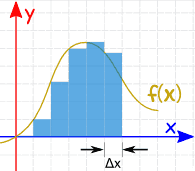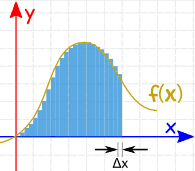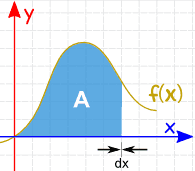How Does At&t Limit Internet Service After Copyright Reddit
Introduction to Integration
Integration is a way of adding slices to find the whole.
Integration can exist used to detect areas, volumes, central points and many useful things. But information technology is easiest to start with finding the area between a function and the 10-centrality similar this:

What is the surface area?
Slices
| We could calculate the part at a few points and add together up slices of width Δx like this (but the answer won't be very accurate): |  | |
| Nosotros can make Δx a lot smaller and add together upwards many small slices (answer is getting better): |  | |
| And equally the slices arroyo zip in width, the respond approaches the true answer. Nosotros at present write dx to hateful the Δx slices are approaching zero in width. |  |
That is a lot of calculation up!
But we don't accept to add together them up, as at that place is a "shortcut", because ...
... finding an Integral is the opposite of finding a Derivative.
(And so y'all should actually know about Derivatives before reading more!)
Like here:
Example: 2x
An integral of 2x is 10ii ...

... considering the derivative of x2 is 2x
(More about "+C" later.)
That simple case can exist confirmed by calculating the surface area:

Area of triangle = 1 2 (base)(height) = i 2 (x)(2x) = 102
Integration can sometimes exist that easy!
Notation
| The symbol for "Integral" is a stylish "Due south" |  |
After the Integral Symbol nosotros put the office we want to find the integral of (called the Integrand),
and so finish with dx to mean the slices go in the x direction (and approach nothing in width).
And hither is how we write the answer:

Plus C
Nosotros wrote the answer as x2 only why +C ?
It is the "Constant of Integration". It is there because of all the functions whose derivative is 2x:

- the derivative of x2 is 2x,
- and the derivative of 102+4 is too 2x,
- and the derivative of ten2+99 is also 2x,
- and then on!
Considering the derivative of a constant is zero.
Then when we contrary the performance (to find the integral) we just know 2x, but there could have been a constant of any value.
So we wrap up the idea past just writing + C at the finish.
A Practical Example: Tap and Tank

Let us use a tap to make full a tank.
The input (earlier integration) is the menstruation rate from the tap.
Nosotros can integrate that period (add up all the lilliputian bits of h2o) to give us the book of water in the tank.
Imagine a Abiding Flow Charge per unit of 1:

An integral of 1 is x
With a flow charge per unit of ane liter per second, the volume increases by 1 liter every second, so would increase by ten liters after x seconds, 60 liters subsequently 60 seconds, etc.
The period rate stays at i, and the book increases by 10
And it works the other way too:
If the tank volume increases by x, and then the menses charge per unit must be 1.
The derivative of 10 is ane
This shows that integrals and derivatives are opposites!

At present For An Increasing Flow Rate
Imagine the period starts at 0 and gradually increases (maybe a motor is slowly opening the tap):

As the flow rate increases, the tank fills up faster and faster:
- Integration: With a flow charge per unit of 2x, the tank volume increases by x2
- Derivative: If the tank volume increases by x2 , then the period rate must be 2x

We can write it downward this way:
| The integral of the menstruum rate 2x tells us the book of water: | ∫2x dx = ten2 + C | |
| The derivative of the volume xtwo+C gives us back the menses rate: | d dx (x2 + C) = 2x |

And hey, we even get a dainty explanation of that "C" value ... maybe the tank already has h2o in it!
- The flow still increases the book by the same amount
- And the increase in volume can give us dorsum the catamenia charge per unit.
Which teaches us to always remember "+C".
Other functions
How do nosotros integrate other functions?
If we are lucky enough to detect the function on the event side of a derivative, then (knowing that derivatives and integrals are opposites) nosotros have an answer. But remember to add C.
Example: what is ∫cos(x) dx ?

From the Rules of Derivatives tabular array we see the derivative of sin(x) is cos(x) and so:
∫cos(x) dx = sin(10) + C
Just a lot of this "reversing" has already been done (run into Rules of Integration).
Example: What is ∫xiii dx ?
On Rules of Integration at that place is a "Power Rule" that says:
∫tenn dx = tennorthward+1 n+1 + C
We can use that dominion with due north=3:
∫x3 dx = x4 4 + C
Knowing how to use those rules is the primal to existence expert at Integration.
And then learn the rules and get lots of practice.
Learn the Rules of Integration and Practice! Practice! Practice!
(in that location are some questions below to get you started)
Definite vs Indefinite Integrals
We take been doing Indefinite Integrals then far.
A Definite Integral has actual values to calculate between (they are put at the lesser and superlative of the "S"):
Read Definite Integrals to learn more than.
How Does At&t Limit Internet Service After Copyright Reddit,
Source: https://www.mathsisfun.com/calculus/integration-introduction.html
Posted by: henryresprommed.blogspot.com


0 Response to "How Does At&t Limit Internet Service After Copyright Reddit"
Post a Comment